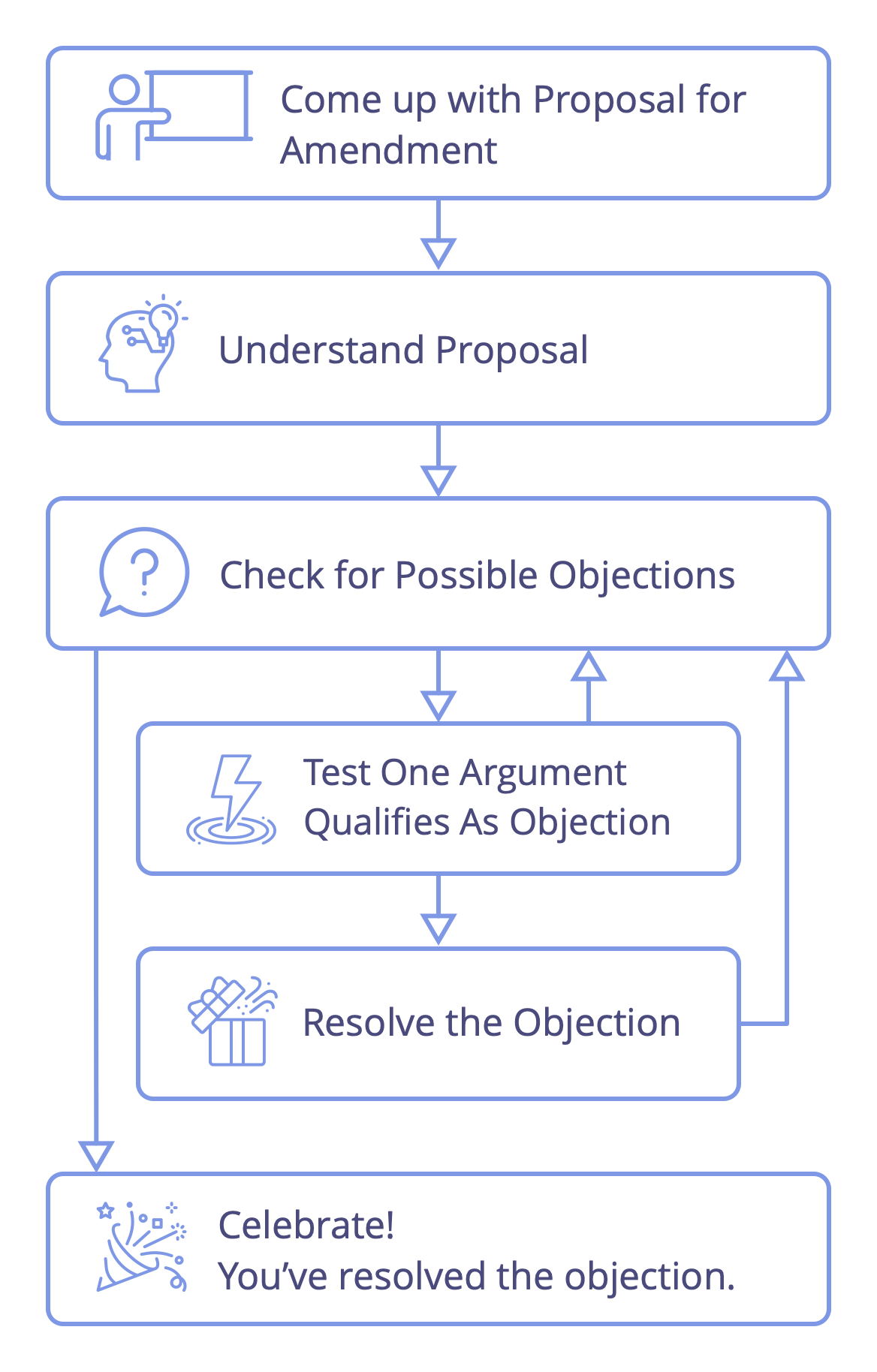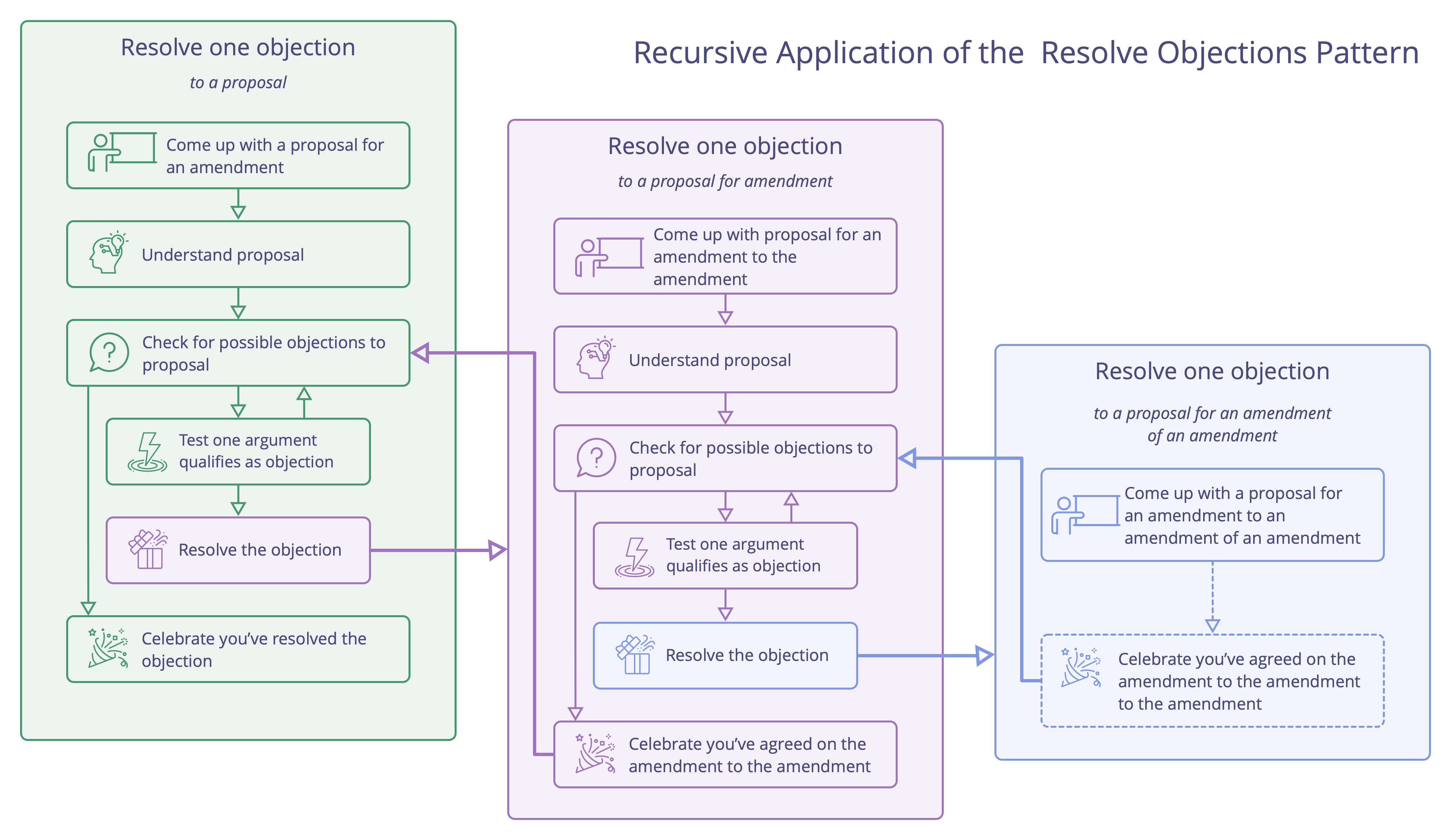Resolve Objections
Typically it’s most effective to take one objection at a time, come up with a proposal for an amendment, resolve any objections to that amendment, and then continue with the next objection to the overall proposal.
A proposal becomes an agreement when all objections have been resolved.
Objections are resolved by amending the proposal. Amendments can include:
- adding, removing and/or changing something in the proposal.
- deferring resolution of a particular objection until later. (Remember to clarify who will take responsibility for this, by when, and what will happen after that).
- an alternative proposal, or an agreement to (co-)create a new proposal in the future (if it’s considered more effective than continuing to work on developing the existing proposal).
- delegating the task to review, research, and/or propose an amendment for one, or even several related objections, to an individual or group.
- leaving the main proposal unchanged and monitoring the outcome because the effort, or cost of changing things to resolve the objection, outweighs the anticipated benefits or gain.
- asking a delegator for feedback or input (e.g. when agreeing on a strategy for a subdomain).
- take some more time for reflection and then come back to the objection again later.
- etc.
There’s always an iterative next step of some kind that you can take! Even if a proposal doesn’t fully address the driver or fulfill the corresponding requirement reaching an agreement about one or more iterative next steps is often good enough. It’s also helpful sometimes to break things down into small steps, especially when you’re dealing with complex or complicated situations.
Objections can be resolved by following the process outlined in Reasoned Decision-Making:
Step 1: Come up with a proposal for an amendment
Step 2: Understand the proposed amendment
Step 3: Check if there are any possible objections to the proposed amendment, e.g. by using hand signs. The possible objections themselves are presented in Step 4.
If there are no possible objections, proceed to step 6 (Celebrate), otherwise take one possible objection at a time, and:
Step 4: Hear the reasoning for the possible objection and determine if the argument put forward has any validity.
Step 5: Integrate any information revealed in the previous step to improve the proposed amendment, then go back to step 3.
Step 6: Celebrate! You’ve agreed on an amendment that resolves the objection!

Below you’ll find more guidance on how to go through each step. This process can be repeated until all objections have been resolved. As with all patterns in S3, your approach to resolving objections can be adjusted to suit your context.
Step 1: Come up with a proposal for an amendment
Come up with a suggestion for how to amend the proposal to resolve the objection based on information the objection reveals.
There are many ways to come up with an amendment. Below are some typical options you can use. We recommend you use them in the order they are presented: if the first option does not work, go to the next one, and so on. Once you get more familiar with the process you’ll be able to discern in the moment which option is more suitable.
- Ask the person raising the objection: “Do you have a suggestion for how to amend this proposal to resolve this objection?”
- Ask the group “Does anyone have a suggestion for how to amend this proposal to resolve this objection?” and choose one person to present their suggestion.
- In case it’s difficult to immediately come up with an amendment, invite a time-boxed dialogue to share ideas, with the purpose of coming up with an amendment from there.
As with any proposal, an amendment suggestion gives you a starting point that can then be refined through inviting and resolving objections. (see Step 4:Test One Argument Qualifies as Objection)
It’s often helpful to repeat or summarize the amendment and write it down for everyone to see.
Step 2: Understand amendment
Ensure everyone understands the amendment being proposed.
Facilitator asks: Any questions to understand the proposed amendment?
Tips for everyone:
- Keep your questions and answers brief and to the point.
- Avoid getting into discussions or expressing opinions about the validity of the amendment at this stage. The point of this step is simply to ensure the suggested amendment is clear.
- Add relevant clarifications to the written amendment.
Step 3: Check for Possible Objections
People consider the proposed amendment and then indicate if they have possible objections or concerns.
This step is simply about identifying who has possible objections or concerns. Arguments are heard in the next step.
Facilitator asks: Are there any possible objections, or concerns to this amendment? (note that the subject here is the amendment, not the whole proposal!)
Many groups use hand signs as a way to indicate quickly and clearly if anyone has any possible objections.
- In case there are possible objections to the suggested amendment, go on to the next step, Test One Argument Qualifies as Objection(link).
- If no one indicates having any possible objections, go to Step 6: Celebrate, because you’ve agreed on the amendment.
Step 4: Test One Argument Qualifies as Objection
Please refer to Test Arguments Qualify as Objections
- If the argument qualifies, continue to Step 5 (Resolve one Objection)
- If the argument doesn’t qualify, go back to Step 3 to check if there are any further possible objections to the proposed amendment.
Step 5: Resolve one Objection
Repeat the process: use the Resolve Objection pattern to resolve one objection to the amendment.
Come up with an amendment to the current amendment suggestion! Be aware that a proposed amendment might include the suggestion to entirely replace the current amendment with a different one instead.
As you can see, the Resolve Objections pattern can be used recursively. Below you will find an illustration that shows how this works.

Step 6: Celebrate!
You’ve agreed on an amendment that resolves the objection! Before moving on, remember to update your original proposal to integrate the amendment you’ve agreed on.